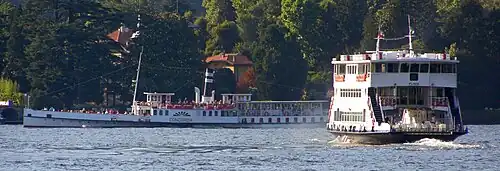Lake Como
Lake Como (Italian: Lago di Como [ˈlaːɡo di ˈkɔːmo], locally [ˈkoːmo]; Western Lombard: Lagh de Còmm [ˈlɑː‿dːe ˈkɔm],[lower-alpha 1] Cómm [ˈkom] or Cùmm [ˈkum]), also known as Lario (Italian: [ˈlaːrjo]; after the Latin: Larius Lacus), is a lake of glacial origin in Lombardy, Italy.
| Lake Como | |
|---|---|
.jpg.webp) | |
 Lake Como | |
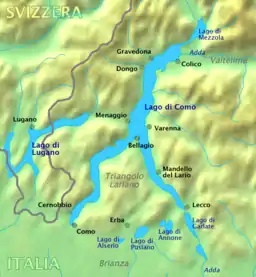 | |
| Location | Lombardy, Italy |
| Coordinates | 46°00′N 9°16′E |
| Native name | |
| Primary inflows | Adda, Mera |
| Primary outflows | Adda |
| Catchment area | 4,509 km2 (1,741 sq mi)[1] |
| Basin countries | Italy, Switzerland |
| Max. length | 46 km (29 mi) |
| Max. width | 4.5 km (2.8 mi) |
| Surface area | 146 km2 (56 sq mi) |
| Average depth | 154 m (505 ft)[1] |
| Max. depth | 425 m (1,394 ft) |
| Water volume | 22.5 km3 (18,200,000 acre⋅ft) |
| Residence time | 5.5 years[1] |
| Shore length1 | 160 km (99 mi) |
| Surface elevation | 198 m (650 ft)[1] |
| Islands | Isola Comacina |
| Settlements | Como, Lecco (see section) |
| References | [1] |
| 1 Shore length is not a well-defined measure. | |
It has an area of 146 square kilometres (56 sq mi), making it the third-largest lake in Italy, after Lake Garda and Lake Maggiore. At over 400 metres (1,300 ft) deep, it is the fifth deepest lake in Europe, and the deepest outside Norway; the bottom of the lake is 227 metres (745 ft) below sea level.
Lake Como has been a popular retreat for aristocrats and wealthy people since Roman times, and a very popular tourist attraction with many artistic and cultural gems. It has many villas and palaces such as Villa Olmo, Villa Serbelloni, and Villa Carlotta. Many famous people have had and have homes on the shores of Lake Como.
One of its particularities is its "Y" shape, which forms the "Larian Triangle", with the little town of Canzo as its capital.
In 2014, The Huffington Post called it the most beautiful lake in the world for its microclimate and environment with prestigious villas and villages.[2]
Etymology
The lake's name in Latin is Larius, Italianized as Lario, but this name is rarely used; it is usually called Lago di Como (literally "lake of Como"). Its name comes from the city of Como, known to the Romans as Comum.
Geography
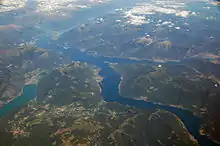
The lake is shaped much like an inverted letter "Y". The northern branch begins at the town of Colico, while the towns of Como and Lecco sit at the ends of the southwestern and southeastern branches respectively. The small towns of Bellagio, Menaggio and Varenna are situated at the intersection of the three branches of the lake: a boat service operates a triangular route between them.[3]
Lake Como is fed primarily by the Adda, which enters the lake near Colico and flows out at Lecco. This geological conformation makes the southwestern branch a dead end, and so Como, unlike Lecco, is often flooded.
The mountainous pre-alpine territory between the two southern arms of the lake (between Como, Bellagio, and Lecco) is known as the Larian Triangle,[4] or Triangolo lariano. The source of the river Lambro is here. At the centre of the triangle, the town of Canzo is the seat of the Comunità montana del Triangolo lariano, an association of the 31 municipalities that represent the 71,000 inhabitants of the area.
Climate
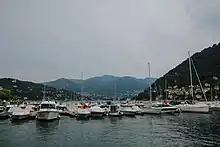
Lake Como's climate is humid subtropical
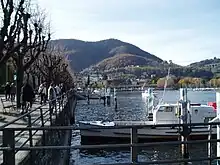
(Cfa under the Köppen climate classification system). In winter, the lake helps to maintain a higher temperature in the surrounding region. Average daily temperatures range from ~3.7 °C (39 °F) in January to 23.4 °C (74 °F) in July, according to historical weather data from Como.[5] Water temperatures can reach an average of 24 °C (75 °F) in July. Snowfall is erratic and occurs mainly at higher elevations. Rainfall is heaviest in May and lowest during the winter months.
| Climate data for Lake Como | |||||||||||||
|---|---|---|---|---|---|---|---|---|---|---|---|---|---|
| Month | Jan | Feb | Mar | Apr | May | Jun | Jul | Aug | Sep | Oct | Nov | Dec | Year |
| Average high °C (°F) | 6.8 (44.2) |
9.0 (48.2) |
12.9 (55.2) |
17.2 (63.0) |
21.1 (70.0) |
25.6 (78.1) |
28.5 (83.3) |
27.2 (81.0) |
23.7 (74.7) |
18.1 (64.6) |
11.7 (53.1) |
7.8 (46.0) |
17.5 (63.5) |
| Daily mean °C (°F) | 3.7 (38.7) |
5.5 (41.9) |
8.8 (47.8) |
12.7 (54.9) |
16.4 (61.5) |
20.7 (69.3) |
23.4 (74.1) |
22.4 (72.3) |
18.9 (66.0) |
14.0 (57.2) |
8.5 (47.3) |
4.7 (40.5) |
13.3 (56.0) |
| Average low °C (°F) | 0.5 (32.9) |
2.0 (35.6) |
4.8 (40.6) |
8.2 (46.8) |
11.8 (53.2) |
15.8 (60.4) |
18.2 (64.8) |
17.6 (63.7) |
14.1 (57.4) |
10.0 (50.0) |
5.3 (41.5) |
1.5 (34.7) |
9.2 (48.5) |
| Average precipitation mm (inches) | 69 (2.7) |
76 (3.0) |
117 (4.6) |
107 (4.2) |
161 (6.3) |
134 (5.3) |
85 (3.3) |
136 (5.4) |
116 (4.6) |
125 (4.9) |
129 (5.1) |
63 (2.5) |
1,318 (51.9) |
| Source: "Climate data for Como". Archived from the original on November 3, 2014. Retrieved March 17, 2019. | |||||||||||||
History
At the beginning of the first millennium B.C. during the Iron Age the Comum oppidum was born and the civilization of Como developed, inserted in the broader Golasecca culture. In 196 B.C. the army of the consul Claudius Marcellus defeats the Celts tribe of the Comenses and conquers the city. Comum was then strengthened and rebuilt after a raid by Rhaetian and repopulated with 3,000 settlers in 77 BC. Finally, after having reclaimed the marshy area, in 59 B.C. it was re-founded with the name of Novum Comun in its current location on the lake shore at the behest of Gaius Julius Caesar.[6]
According to the Notitia Dignitatum, at least since the 4th century, a Praefectus commanding a Roman military fleet was present on the lake.[7]
During the Middle Ages and the Renaissance, the waters of the lake were the scene of military clashes, such as in the 12th century during the war of Milan against Como, which saw the Como fleet in action against the ships of the Milanese and their allies or between 1525 and 1532 due to the Musso war unleashed by Gian Giacomo Medici.[8]
Tourism and Economy
As a tourist destination, Lake Como is popular for its landscapes, wildlife, and spas.[9] It is a venue for sailing, windsurfing, and kitesurfing.[10]
Although generally considered safe, bathers aiming to find relief from the heat and swimming enthusiasts alike should exercise caution, as a prevailing regulation prohibits diving and swimming both in the city of Como and in the various small villages along the lake. Exceptions are found only in privately managed lidos or designated public beaches where explicit signage permits swimming activities. This prohibition stems from the danger posed by the lake's waters that swiftly transition from shallow to deep in close proximity to the shoreline and from unpredictable aquatic conditions, which have led to numerous unfortunate incidents, including drowning cases attributed to sudden thermal shock.[11][12][13][14]
In the area surrounding Lake Como there are several farms which produce goods such as honey, olive oil, cheese, milk, eggs and salamis. Visitors can find lists of these farms and typically visit the farm itself in person to make their purchases.[15]
Lakeside villas

_-_DSC02504.JPG.webp)
_-_DSC02854.JPG.webp)
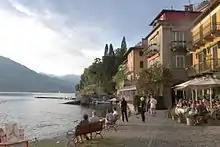


The lake is well known for the attractive villas that have been built there since Roman times, when Pliny the Younger built the Comedia and the Tragedia resorts. Many villas on the lake shores have admirable gardens that benefit from the mild climate induced by the stabilizing presence of 22.5 cubic kilometres (5.4 cu mi) of lake water and can sustain many subtropical and Mediterranean plants.
Villa Carlotta was built for the Milanese Marquis Giorgio Clerici in 1690 and occupies a site of over 7 hectares (17 acres) at Tremezzo, facing the Bellagio peninsula. An Italian garden (with steps, fountains, and sculptures) was laid out at the same time. The villa was later sold to powerful banker and Napoleonic politician Giovanni Battista Sommariva. Stendhal was his guest in 1818, and his visit is recalled at the start of La Chartreuse de Parme. In 1843 it was purchased by Princess Marianne of Nassau as a wedding present for her daughter Carlotta, after whom the villa is now named. The latter, together with her husband Georg II of Saxen-Meiningen, laid out the woodland landscape park in Romantic style. The villa today includes a museum of agricultural implements as well as important works of sculpture by Sommariva's friend Antonio Canova and by Luigi Acquisti.[16]
Villa d'Este, in Cernobbio, was built in 1568 by Cardinal Tolomeo Gallio, a native of the town. In 1816–1817 the villa was home to Caroline of Brunswick, estranged wife of the Prince of Wales and shortly to become Queen Consort of King George IV of the United Kingdom. The landscaped gardens in the English style are a product of this period. Later in the century it was turned into a luxury hotel. Today the Villa d'Este is known for attracting celebrity guests.
Villa del Balbianello, famous for its elaborate terraced gardens, lies on a promontory of the western shore of the lake near Isola Comacina. Built in 1787 on the site of a Franciscan monastery, it was the final home of the explorer Guido Monzino and today houses a museum devoted to his work.
Villa Melzi d'Eril in Bellagio was built in neo-classical style by architect Giocondo Albertolli in 1808–1810 as the summer residence of Duke Francesco Melzi d'Eril, who was vice-president of the Napoleonic Italian Republic. The park includes an orangery, a private chapel, fine statues, and a Japanese garden, and is planted, as often on lake Como, with huge rhododendrons. 19th-century guests at the Villa included Stendhal and Franz Liszt.[17]
Villa Serbelloni, also in Bellagio, hosts the Rockefeller Foundation Bellagio Center, a 50-acre (200,000 m2) international conference center set up and managed by the Rockefeller Foundation since 1959, which also operates a "scholar-in-residence" program for scholars from around the world. This is believed to have been the site of Pliny the Younger's villa "Tragedia". Its well-known park was created at the end of the 18th century by Alessandro Serbelloni.
Many famous people have or have had homes on the shores of Lake Como, such as Matthew Bellamy, John Kerry, Madonna, George Clooney,[18] Gianni Versace, Ronaldinho, Sylvester Stallone, Julian Lennon, Richard Branson, Ben Spies, Pierina Legnani, Lionel Messi and José Mourinho.
Ferries
The Lake Como ferry service is a highly developed public transport system linking the many small towns around the Lake. A motorized service began in 1826 when a steamship with sails, the Lario, was launched by the newly established Società privilegiata per l'impresa dei battelli a vapore nel Regno Lombardo Veneto. Since 1952 the system has been run under the auspices of a government organization called first the Gestione Commissariale Governativa and subsequently the Gestione Governativa Navigazione Laghi, which is also responsible for services on Lake Maggiore and Lake Garda.[19][20]
Today there are three main services:
- Motorship services along the western branch and northern end of the Lake (between Colico or Piona and Como town), with additional shuttles to the mid-lake area.
- Fast services that follow broadly the same route, but use faster hydrofoils, stop less frequently, and cost extra.
- Ferries that run only between the popular mid-lake villages of Menaggio, Bellagio, and Varenna, plus Cadenabbia. Some of these boats carry vehicles as well as passengers.[21]
Sacro Monte di Ossuccio
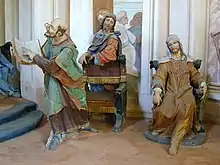
The Sacro Monte di Ossuccio ("Holy Mount of Ossuccio") is a sanctuary located on a hillside slope between olive groves and woods along the western edge of Lake Como facing Isola Comacina. Fifteen Baroque inspired chapels, built between 1635 and 1710, and dedicated to the Mysteries of the Rosary are dotted along the way that leads to the Monastery. This building is the last in the chain and is dedicated to the Coronation of the Virgin.
In 2003, the Sacri Monti of Piedmont and Lombardy, including that of Ossuccio, were added by UNESCO to the World Heritage List.
Villages, resorts, and other notable localities near the lake
.jpg.webp)

| Western shore from North to South |
South shore from West to East |
Eastern shore from North to South |
|---|---|---|
In literature and the arts
- Letitia Elizabeth Landon's poem The Lake of Como was published in Fisher's Drawing Room Scrap Book, 1837. It illustrates a painting by Samuel Prout, engraved by William Miller.[22]
- In 1818 Percy Bysshe Shelley wrote to Thomas Love Peacock: "This lake exceeds anything I ever beheld in beauty, with the exception of the arbutus islands of Killarney. It is long and narrow, and has the appearance of a mighty river winding among the mountains and the forests."[23]
Gallery
See also
References
- "Laghi italiani". Istituto Italiano di Idrobiologia. Archived from the original on 2010-02-05. Retrieved 2006-11-17.
- "The World's 20 Most Beautiful Lakes". The Huffington Post. 2014. Retrieved 22 May 2017.
- "Lake Como, Italy: the best things to do". Lake Como Travel.
- The meaning of Larian is "related to the Lake Como", since the Latin name of Lake Como was Larius. So, the expression Triangolo lariano, or, in English, Larian Triangle, means exactly "Lake Como Triangle" or "Triangle of the Lake Como".
- "Climate data for Como". Archived from the original on 2014-11-03. Retrieved 2016-03-31.
- lakecomotravel.com. "COMO HISTORY". lakecomotravel.com. Retrieved 26 April 2023.
- Brogiolo, Gian Pietro; Gelichi, Sauro (1996). Nuove ricerche sui castelli altomedievali in Italia settentrionale [New research on early medieval castles in northern Italy] (in Italian). Firenze: All'Insegna del Giglio. p. 40. ISBN 978-8878141070. Retrieved 26 April 2023.
- Romanoni, Fabio (2023). La guerra d'acqua dolce. Navi e conflitti medievali nell'Italia settentrionale. Bologna: Clueb. pp. 108–109. ISBN 978-88-31365-53-6. Retrieved 26 April 2023.
- Lake Como holidays, inghams.com, April 20, 2010
- 2006 Kiteboard Pro World Tour event, Lake Como, Italiaspeed.com, June 6, 2006
- "National football player drowns in Lake Como". Swiss Info. Retrieved 2023-08-18.
- "A terrible year with many victims of the depths during summer". La Provincia di Como. Retrieved 2023-08-18.
- "Girl who drowned in Lake Como named". Ansa. Retrieved 2023-08-18.
- "slips off an inflatable and drowns". Italy 24 news. Retrieved 2023-08-18.
- "Directly from the producer - Lago di Como". www.lakecomo.it. Archived from the original on 2017-09-04. Retrieved 2016-04-10.
- See Infoparchi, Villa Carlotta; Villacarlotta.it, Villa Carlotta; Macadam, Alta
- See Infoparchi, Villa Melzi.
- "Lifeinitaly.com". Archived from the original on 2009-11-06.
- Massimo Gozzi, "History of Navigation on Lake Como" Archived 2009-10-15 at the Wayback Machine, Gestione Governativa Navigazione Laghi, 2007, pp 1–2.
- "General Management" Archived 2010-05-05 at the Wayback Machine, Gestione Governativa Navigazione Laghi, 2007.
- "'Autumn Timetable 2009' Gestione Governativa Navigazione Laghi". Archived from the original on 2010-03-16.
- Landon, Letitia Elizabeth (1836). "picture". Fisher's Drawing Room Scrap Book, 1837. Fisher, Son & Co.Landon, Letitia Elizabeth (1836). "poetical illustration". Fisher's Drawing Room Scrap Book, 1837. Fisher, Son & Co.
- Francis W Halsey, ed. (1914). Seeing Europe with Famous Authors. Vol. VIII. Funk & Wagnells.
Notes
- In isolation, lagh is pronounced [ˈlɑːk].
Further reading
- Coolidge, William Augustus Brevoort (1911). . Encyclopædia Britannica. Vol. 6 (11th ed.). p. 794.
- Macadam, Alta (1997). Blue Guide. Northern Italy: From the Alps to Bologna. London: A & C Black. ISBN 0-7136-4294-7.
